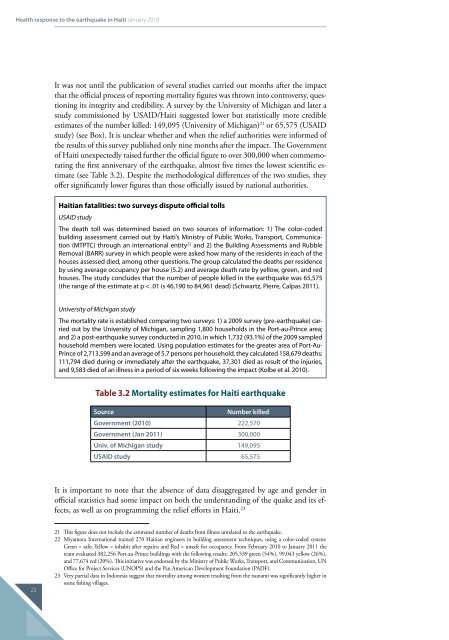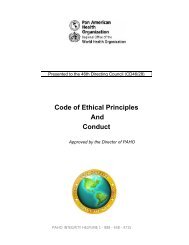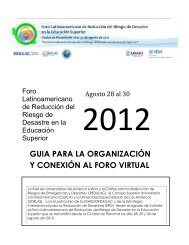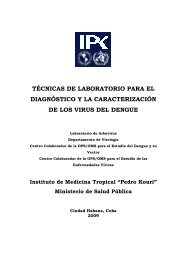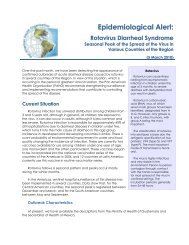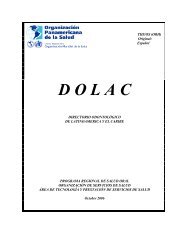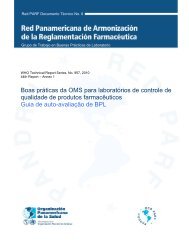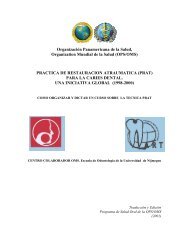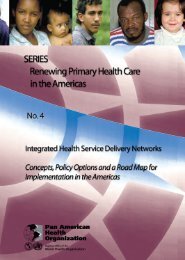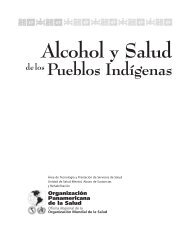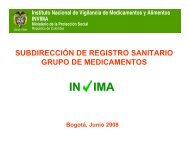Health response to the earthquake in Haiti, January 2010
Health response to the earthquake in Haiti, January 2010
Health response to the earthquake in Haiti, January 2010
- No tags were found...
You also want an ePaper? Increase the reach of your titles
YUMPU automatically turns print PDFs into web optimized ePapers that Google loves.
<strong>Health</strong> <strong>response</strong> <strong>to</strong> <strong>the</strong> <strong>earthquake</strong> <strong>in</strong> <strong>Haiti</strong> <strong>January</strong> <strong>2010</strong>It was not until <strong>the</strong> publication of several studies carried out months after <strong>the</strong> impactthat <strong>the</strong> official process of report<strong>in</strong>g mortality figures was thrown <strong>in</strong><strong>to</strong> controversy, question<strong>in</strong>gits <strong>in</strong>tegrity and credibility. A survey by <strong>the</strong> University of Michigan and later astudy commissioned by USAID/<strong>Haiti</strong> suggested lower but statistically more credibleestimates of <strong>the</strong> number killed: 149,095 (University of Michigan) 21 or 65,575 (USAIDstudy) (see Box). It is unclear whe<strong>the</strong>r and when <strong>the</strong> relief authorities were <strong>in</strong>formed of<strong>the</strong> results of this survey published only n<strong>in</strong>e months after <strong>the</strong> impact. The Governmen<strong>to</strong>f <strong>Haiti</strong> unexpectedly raised fur<strong>the</strong>r <strong>the</strong> official figure <strong>to</strong> over 300,000 when commemorat<strong>in</strong>g<strong>the</strong> first anniversary of <strong>the</strong> <strong>earthquake</strong>, almost five times <strong>the</strong> lowest scientific estimate(see Table 3.2). Despite <strong>the</strong> methodological differences of <strong>the</strong> two studies, <strong>the</strong>yoffer significantly lower figures than those officially issued by national authorities.<strong>Haiti</strong>an fatalities: two surveys dispute official <strong>to</strong>llsUSAID studyThe death <strong>to</strong>ll was determ<strong>in</strong>ed based on two sources of <strong>in</strong>formation: 1) The color-codedbuild<strong>in</strong>g assessment carried out by <strong>Haiti</strong>’s M<strong>in</strong>istry of Public Works, Transport, Communication(MTPTC) through an <strong>in</strong>ternational entity 22 and 2) <strong>the</strong> Build<strong>in</strong>g Assessments and RubbleRemoval (BARR) survey <strong>in</strong> which people were asked how many of <strong>the</strong> residents <strong>in</strong> each of <strong>the</strong>houses assessed died, among o<strong>the</strong>r questions. The group calculated <strong>the</strong> deaths per residenceby us<strong>in</strong>g average occupancy per house (5.2) and average death rate by yellow, green, and redhouses. The study concludes that <strong>the</strong> number of people killed <strong>in</strong> <strong>the</strong> <strong>earthquake</strong> was 65,575(<strong>the</strong> range of <strong>the</strong> estimate at p < .01 is 46,190 <strong>to</strong> 84,961 dead) (Schwartz, Pierre, Calpas 2011).University of Michigan studyThe mortality rate is established compar<strong>in</strong>g two surveys: 1) a 2009 survey (pre-<strong>earthquake</strong>) carriedout by <strong>the</strong> University of Michigan, sampl<strong>in</strong>g 1,800 households <strong>in</strong> <strong>the</strong> Port-au-Pr<strong>in</strong>ce area;and 2) a post-<strong>earthquake</strong> survey conducted <strong>in</strong> <strong>2010</strong>, <strong>in</strong> which 1,732 (93.1%) of <strong>the</strong> 2009 sampledhousehold members were located. Us<strong>in</strong>g population estimates for <strong>the</strong> greater area of Port-Au-Pr<strong>in</strong>ce of 2,713,599 and an average of 5.7 persons per household, <strong>the</strong>y calculated 158,679 deaths:111,794 died dur<strong>in</strong>g or immediately after <strong>the</strong> <strong>earthquake</strong>, 37,301 died as result of <strong>the</strong> <strong>in</strong>juries,and 9,583 died of an illness <strong>in</strong> a period of six weeks follow<strong>in</strong>g <strong>the</strong> impact (Kolbe et al. <strong>2010</strong>).Table 3.2 Mortality estimates for <strong>Haiti</strong> <strong>earthquake</strong>SourceNumber killedGovernment (<strong>2010</strong>) 222,570Government (Jan 2011) 300,000Univ. of Michigan study 149,095USAID study 65,575It is important <strong>to</strong> note that <strong>the</strong> absence of data disaggregated by age and gender <strong>in</strong>official statistics had some impact on both <strong>the</strong> understand<strong>in</strong>g of <strong>the</strong> quake and its effects,as well as on programm<strong>in</strong>g <strong>the</strong> relief efforts <strong>in</strong> <strong>Haiti</strong>. 232221 This figure does not <strong>in</strong>clude <strong>the</strong> estimated number of deaths from illness unrelated <strong>to</strong> <strong>the</strong> <strong>earthquake</strong>.22 Miyamota International tra<strong>in</strong>ed 270 <strong>Haiti</strong>an eng<strong>in</strong>eers <strong>in</strong> build<strong>in</strong>g assessment techniques, us<strong>in</strong>g a color-coded system:Green = safe; Yellow = <strong>in</strong>habit after repairs; and Red = unsafe for occupancy. From February <strong>2010</strong> <strong>to</strong> <strong>January</strong> 2011 <strong>the</strong>team evaluated 382,256 Port-au-Pr<strong>in</strong>ce build<strong>in</strong>gs with <strong>the</strong> follow<strong>in</strong>g results: 205,539 green (54%), 99,043 yellow (26%),and 77,674 red (20%). This <strong>in</strong>itiative was endorsed by <strong>the</strong> M<strong>in</strong>istry of Public Works, Transport, and Communication, UNOffice for Project Services (UNOPS) and <strong>the</strong> Pan American Development Foundation (PADF).23 Very partial data <strong>in</strong> Indonesia suggest that mortality among women result<strong>in</strong>g from <strong>the</strong> tsunami was significantly higher <strong>in</strong>some fish<strong>in</strong>g villages.


